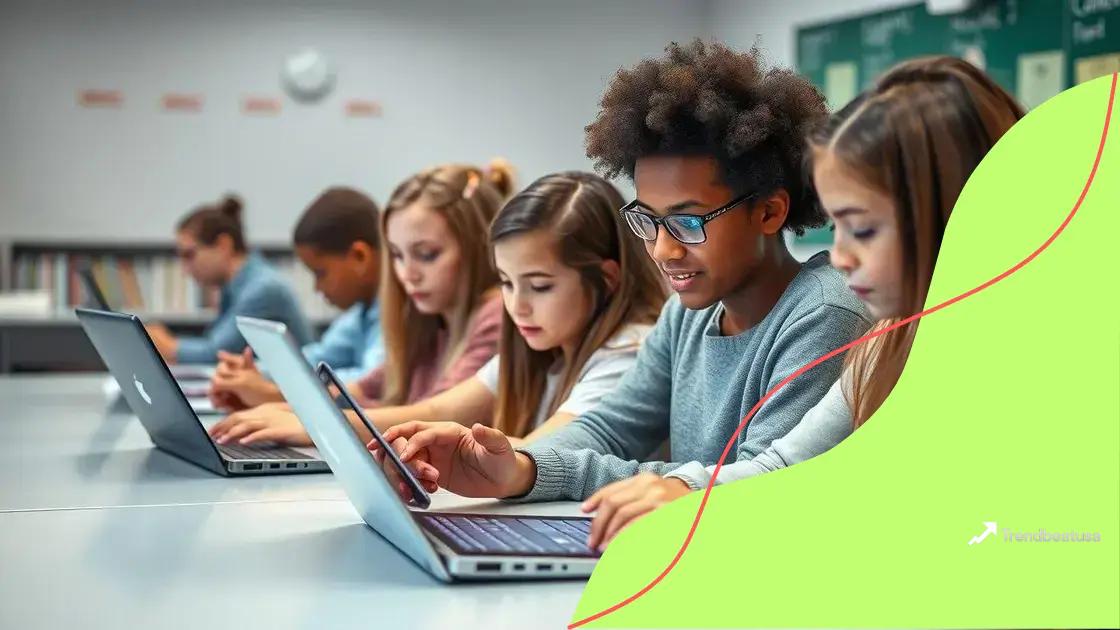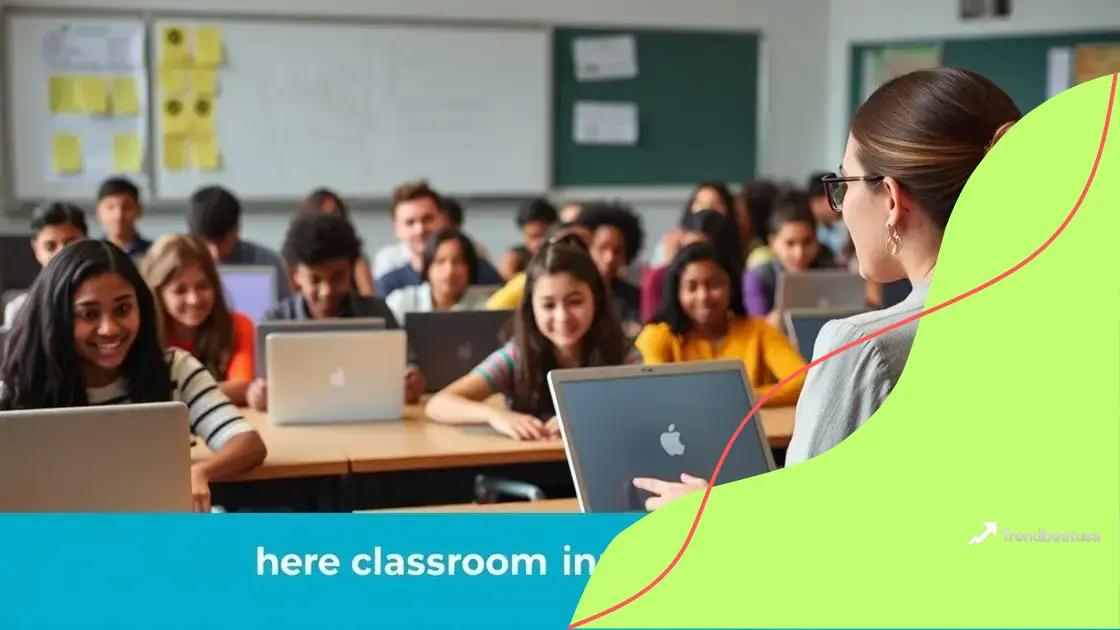Tech use in classrooms expands: the future of learning

Integrating technology in classrooms enhances engagement, personalizes learning, facilitates collaboration, and enables data-driven decisions, resulting in improved educational outcomes for students.
Tech use in classrooms expands opportunities for interactive learning and engagement among students. Have you wondered how technology shapes the educational landscape today? Let’s dive into its many facets.
The evolution of technology in education
The evolution of technology in education has transformed the way students learn and teachers instruct. With the integration of various digital tools, classrooms have become more engaging and interactive. This evolution reflects the changing needs of students in a tech-savvy world. Imagine a classroom where information flows seamlessly and learning feels like a game!
Historical Overview
In the past, education relied heavily on traditional teaching methods, with teachers lecturing and students taking notes. Today, technology has reshaped this model significantly.
Key Developments in Educational Technology
- The introduction of personal computers and laptops, making information accessible.
- The rise of educational software that enhances learning experiences.
- Increased Internet access, enabling online learning and resources.
Additionally, online platforms like Google Classroom and edX offer students flexible learning options. These tools allow teachers to share resources and assignments efficiently. Besides, virtual classrooms enable collaboration beyond geographical boundaries.
Current Trends
Now more than ever, students are using tablets and smartphones to engage with their studies. The use of interactive whiteboards and educational apps also aids in understanding complex subjects. Teachers adapt their lessons in real-time based on student feedback, which is made simpler by technology.
The future is bright for educational technology. With advancements like artificial intelligence and virtual reality, learning experiences are becoming more immersive. These tools provide personalized learning paths that cater to individual student needs, making education more effective and enjoyable.
Benefits of integrating tech in classrooms
Integrating technology in classrooms offers many benefits for both students and teachers. This change has made learning more interactive and engaging. It’s exciting to see how technology can enhance traditional education.
Engagement and Motivation
One major benefit is that technology increases student engagement. When students use tablets, computers, and interactive whiteboards, learning becomes a more enjoyable experience. Visual aids and interactive content keep students interested.
Personalized Learning
Another advantage is the ability to provide personalized learning experiences. With various tools, teachers can tailor lessons to fit the needs of individual students. This is especially helpful for those who learn at different paces.
- Students can choose their own learning paths.
- Teachers can track progress with data.
- Accessible resources cater to diverse learning styles.
Moreover, technology facilitates instant feedback. Instead of waiting for grades, students receive immediate results on quizzes and assignments. This quick response helps them understand their strengths and areas for improvement right away.
Collaboration Opportunities
Technology also promotes collaboration. Platforms like Google Classroom allow students to work together on projects from different locations. They can share ideas, edit documents in real-time, and communicate effectively. This not only builds teamwork skills but also prepares students for the modern workforce.
By integrating tech into education, teachers can enhance their teaching methods. It opens up a world of resources, enabling educators to find new ways to explain complex concepts. Tools like videos, simulations, and educational games bring lessons to life.
Challenges faced by educators

While integrating technology into classrooms offers numerous benefits, it also presents several challenges for educators. Understanding these obstacles is crucial to finding effective solutions and enhancing the learning experience.
Training and Support
One challenge that many teachers face is the need for adequate training and ongoing support. Not all educators are comfortable with new technology, which can hinder its effectiveness in the classroom. Professional development programs should be in place to help teachers become proficient in using these tools.
Access to Technology
Another significant issue is access to technology. In some areas, schools lack sufficient devices for all students. This can lead to a digital divide, making it difficult for some learners to benefit from tech-enhanced education. Schools must seek funding and partnerships to ensure equitable access.
- Implementing BYOD policies (bring your own device) may help.
- Community resources can provide additional support for devices.
- Collaborations with tech companies can enhance technology access.
Moreover, there is often resistance to change. Some educators may be hesitant to adopt new methods, sticking with familiar but outdated practices. Change management strategies are essential to encourage teachers to embrace innovative technology.
Classroom Management
Technology can also complicate classroom management. With devices available, distractions can arise as students may be tempted to wander to non-educational websites or apps. Teachers must balance allowing freedom with maintaining focus. Establishing clear guidelines and using monitoring software can help manage these challenges.
Another challenge is ensuring that technology complements the curriculum rather than replaces traditional teaching methods. It’s vital for educators to find a balance between using tech and maintaining personal interactions with students. This balance fosters a supportive learning environment where all students thrive.
Future trends in classroom technology
The future trends in classroom technology promise exciting changes that will further enhance learning experiences for students. As innovations emerge, schools will have more opportunities to engage students and streamline teaching.
Increased Use of Artificial Intelligence
One prominent trend is the rise of artificial intelligence (AI) in education. AI can personalize learning by adapting content to meet individual student needs. For example, AI-driven platforms assess students’ strengths and weaknesses, offering tailored resources to support their learning journeys.
Virtual and Augmented Reality
Moreover, virtual reality (VR) and augmented reality (AR) will play critical roles in making lessons come alive. These technologies allow students to explore immersive environments. Imagine studying history by virtually walking through ancient cities or learning science by witnessing molecular interactions in a 3D space.
- VR can make remote learning interactive and engaging.
- AR can enhance textbooks with additional digital content.
- Both technologies can promote experiential learning.
Another key aspect of future trends is the increasing use of collaborative learning tools. As remote education becomes more common, tools that facilitate teamwork will be vital. Applications that allow students to work on projects together in real time, regardless of their location, enhance communication skills and critical thinking.
Data-Driven Decision Making
Data analytics will also play a significant role in shaping the future classroom. Educators will use data to track student progress and make informed decisions about instructional strategies. By analyzing performance data, teachers can identify areas where students need more support and adjust their approaches accordingly.
Lastly, gamification will transform traditional learning. Incorporating game elements into lessons can boost motivation and engagement. As students progress through challenges, they earn rewards and recognition, making learning fun and interactive.
Case studies of successful tech implementations
Exploring case studies of successful tech implementations provides valuable insights into how technology can transform classrooms. These examples highlight the benefits and best practices for integrating technology into education.
Interactive Learning at the XYZ School
At XYZ School, teachers implemented interactive whiteboards in all classrooms. This allowed students to engage with lessons by participating actively. The use of these boards increased class participation by 30% and improved understanding of complex subjects.
Blended Learning at ABC Academy
ABC Academy adopted a blended learning model, mixing traditional teaching methods with online resources. Students took online courses at their own pace while attending in-person sessions for discussions. This approach led to higher student satisfaction and an impressive 15% rise in overall grades.
- Students appreciated the flexibility of learning.
- Teachers were able to provide more personalized attention.
- Data tracking from online platforms helped identify areas needing improvement.
Furthermore, at DEF High School, the incorporation of virtual reality (VR) technology in the science curriculum enabled students to experience scientific concepts firsthand. For example, virtual field trips to remote locations allowed students to explore ecosystems without leaving the classroom.
STEM Innovations in GHI School District
The GHI School District launched a technology initiative focusing on STEM (Science, Technology, Engineering, and Mathematics) education. They provided students with coding clubs and robotics programs, increasing interest in these fields. This resulted in increased enrollment in advanced STEM courses.
These case studies demonstrate that when technology is implemented effectively, it can lead to enhanced learning experiences. Schools that prioritize training and support for educators had the most success. They created environments where students could thrive, showcasing the power of technology in education.
FAQ – Frequently Asked Questions about Technology in Classrooms
How does technology increase student engagement?
Technology makes learning interactive by using tools like interactive whiteboards and educational games, which capture students’ interest and encourage participation.
What are the benefits of personalized learning through technology?
Personalized learning tools adapt to each student’s needs, helping them learn at their own pace and improving their understanding of the material.
How can technology facilitate collaboration among students?
Educational platforms allow students to work together in real-time, share ideas, and complete projects, promoting teamwork and communication skills.
What role does data play in enhancing education with technology?
Data helps educators track student progress and make informed decisions about teaching strategies, ensuring that students receive the support they need.
